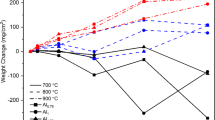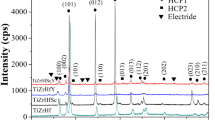Abstract
Ti2−xNiCoSnSb (x = 0.125, 0.250, 0.375, and 0.500) half Heusler (HH) high-entropy thermoelectric alloys were synthesized by the arc melting—ball milling—spark plasma sintering route. The impact of secondary phase content on the thermoelectric properties in these alloys was examined. Ni-rich intermetallic (Ni3Sn2, Ni3Sn4) compounds were observed; the intermetallic content increased for lower Ti content, e.g., Ti1.5NiCoSnSb. A Ni-rich full Heusler (FH) secondary phase was also observed. These results were consistent with first-principles calculations that show that the formation enthalpy of Ti1.5NiCoSnSb was higher than that of Ti2NiCoSnSb and the full Heusler (FH) TiNi2Sn phase. In lower Ti content samples, the electrical conductivity increased, and lattice thermal conductivity decreased at the expense of thermopower owing to higher FH and the Ni3Sn2 phase content. Ti1.5NiCoSnSb exhibited lower lattice thermal conductivity of 3.5 W/mK, compared to 5.4 W/mK at 823 K for Ti2NiCoSnSb due to increased phonon scattering at HH/Ni3Sn2 interfaces. But considering the decreasing power factor with lower Ti content, the maximum ZT obtained in Ti1.875NiCoSnSb (0.171 at 973 K) was only marginally higher than the value for Ti2NiCoSnSb. Further, compositional tuning is hence necessary to maximize the power factor.
Graphical abstract











Similar content being viewed by others
Data availability
The detailed parameters used for DFT calculations, and the csv files of the raw data are available on request to the corresponding author. Data on densities, EDS analysis, lattice parameters and enthalpies are given in the Supporting data file.
References
Beretta D, Neophytou N, Hodges JM et al (2019) Thermoelectrics: from history, a window to the future. Mater Sci Eng R Rep 138:210–255. https://doi.org/10.1016/j.mser.2018.09.001
Yurddaskal M, Yurddaskal M, Yilmaz O, Gultekin S (2021) Thermoelectric films for electricity generation. In: Song Y (ed) Inorganic and organic thin films. Wiley, New York, pp 299–339
Hu B, Shi XL, Zou J, Chen ZG (2022) Thermoelectrics for medical applications: progress, challenges, and perspectives. Chem Eng J 437:135268. https://doi.org/10.1016/j.cej.2022.135268
Ochieng AO, Megahed TF, Ookawara S, Hassan H (2022) Comprehensive review in waste heat recovery in different thermal energy-consuming processes using thermoelectric generators for electrical power generation. Process Saf Environ Prot 162:134–154. https://doi.org/10.1016/j.psep.2022.03.070
Al-Tahaineh H, AlEssa AHM (2022) A hybrid TEG/evacuated tube solar collectors for electric power generation and space heating. J Eng Appl Sci 69:1–15. https://doi.org/10.1186/s44147-021-00065-1
Farrar-Foley N, Rongione N, Wu H, Lavine AS, Hu Y (2021) Total solar spectrum energy converter with integrated photovoltaics, thermoelectrics, and thermal energy storage: system modeling and design. Int J Energy Res 46:5731–5744. https://doi.org/10.1002/er.7518
Freer R, Powell AV (2020) Realising the potential of thermoelectric technology: a roadmap. J Mater Chem C 8:441–463. https://doi.org/10.1039/c9tc05710b
Vedernikov MV, Iordanishvili EK (1998) A. F. Ioffe and origin of modern semiconductor thermoelectric energy conversion. Int Conf Thermoelectr 17:37–42
Fitriani OR, Long BD et al (2016) A review on nanostructures of high-temperature thermoelectric materials for waste heat recovery. Renew Sustain Energy Rev 64:635–659. https://doi.org/10.1016/j.rser.2016.06.035
Baday C, Yurddaskal M, Ozgul M, Zor M (2017) Production, characterization and optimization of thermoelectric module and investigation of doping effects on thermoelectric performances. J Mater Sci Mater Electron 28:17468–17481. https://doi.org/10.1007/s10854-017-7681-0
Sootsman JR, Chung DY, Kanatzidis MG (2009) New and old concepts in thermoelectric materials. Angew Chemie Int Ed 48:8616–8639. https://doi.org/10.1002/anie.200900598
Poon SJ (2019) Half Heusler compounds: promising materials for mid-to-high temperature thermoelectric conversion. J Phys D Appl Phys 52:493001. https://doi.org/10.1088/1361-6463/ab3d71
Liu R, Xing Y, Liao J et al (2022) Thermal-inert and ohmic-contact interface for high performance half-Heusler based thermoelectric generator. Nat Commun 13:7738. https://doi.org/10.1038/s41467-022-35290-6
Quinn RJ, Bos JWG (2021) Advances in half-Heusler alloys for thermoelectric power generation. Mater Adv 2:6246–6266. https://doi.org/10.1039/d1ma00707f
Chen K, Zhang R, Bos JWG, Reece MJ (2022) Synthesis and thermoelectric properties of high-entropy half-Heusler MFe1−xCoxSb (M = equimolar Ti, Zr, Hf, V, Nb, Ta). J Alloys Compd 892:162045. https://doi.org/10.1016/j.jallcom.2021.162045
Sekimoto T, Kurosaki K, Muta H, Yamanaka S (2006) Thermoelectric properties of Sn-doped TiCoSb half-Heusler compounds. J Alloys Compd 407:326–329. https://doi.org/10.1016/j.jallcom.2005.06.036
Wang Q, Xie X, Li S et al (2021) Enhanced thermoelectric performance in Ti(Fe Co, Ni)Sb pseudo-ternary Half-Heusler alloys. J Mater 7:756–765. https://doi.org/10.1016/j.jmat.2020.12.015
Karati A, Murty BS (2017) Synthesis of nanocrystalline half-Heusler TiNiSn by mechanically activated annealing. Mater Lett 205:114–117. https://doi.org/10.1016/j.matlet.2017.06.068
Bahrami A, Ying P, Wolff U et al (2021) Reduced lattice thermal conductivity for half-Heusler ZrNiSn through cryogenic mechanical alloying. ACS Appl Mater Interfaces 13:38561–38568. https://doi.org/10.1021/acsami.1c05639
Tillard M, Berche A, Jund P (2018) Synthesis of pure NiTiSn by mechanical alloying: an investigation of the optimal experimental conditions supported by first principles calculations. Metals (Basel) 8:835. https://doi.org/10.3390/met8100835
Park G, Lee HS, Yi S (2022) Effects of annealing on the microstructure and thermoelectric properties of half-Heusler MNiSn (M = Ti, Zr, Hf). J Electron Mater 51:3485–3494. https://doi.org/10.1007/s11664-022-09627-2
Chen LD, Huang XY, Zhou M et al (2006) The high temperature thermoelectric performances of Zr0.5Hf0.5Ni0.8Pd0.2Sn0.99Sb0.01 alloy with nanophase inclusions. J Appl Phys 99:064305. https://doi.org/10.1063/1.2180432
Makongo JPA, Misra DK, Zhou X et al (2011) Simultaneous large enhancements in thermopower and electrical conductivity of bulk nanostructured half-Heusler alloys. J Am Chem Soc 133:18843–18852. https://doi.org/10.1021/ja206491j
Yang X, Wang Y, Min R et al (2022) Enhancement in thermoelectric properties of ZrNiSn-based alloys by Ta doping and Hf substitution. Acta Mater 233:117976. https://doi.org/10.1016/j.actamat.2022.117976
Al HMA, Wang J, Shin S et al (2021) Effects of aluminum content on thermoelectric performance of AlxCoCrFeNi high-entropy alloys. J Alloys Compd 883:160811. https://doi.org/10.1016/j.jallcom.2021.160811
Ren W, Shi X, Wang Z, Ren Z (2022) Crystallographic design for half-Heuslers with low lattice thermal conductivity. Mater Today Phys 25:100704. https://doi.org/10.1016/j.mtphys.2022.100704
Graf T, Klaer P, Barth J et al (2010) Phase separation in the quaternary Heusler compound CoTi(1–x)MnxSb - A reduction in the thermal conductivity for thermoelectric applications. Scr Mater 63:1216–1219. https://doi.org/10.1016/j.scriptamat.2010.08.039
Karati A, Nagini M, Ghosh S et al (2019) Ti2NiCoSnSb - a new half-Heusler type high-entropy alloy showing simultaneous increase in Seebeck coefficient and electrical conductivity for thermoelectric applications. Sci Rep 9:5331. https://doi.org/10.1038/s41598-019-41818-6
Karati A, Mishra SR, Ghosh S et al (2022) Thermoelectric properties of a high entropy half-Heusler alloy processed by a fast powder metallurgy route. J Alloys Compd 924:166108. https://doi.org/10.1016/j.jallcom.2022.166108
Hoch M, Vardi J (1963) Thermal conductivity of TiC. J Am Ceram Soc 46:245
He R, Huang L, Wang Y et al (2016) Enhanced thermoelectric properties of n-type NbCoSn half-Heusler by improving phase purity. APL Mater 4:104804. https://doi.org/10.1063/1.4952994
Ferluccio DA, Smith RI, Buckman J, Bos JWG (2018) Impact of Nb vacancies and p-type doping of the NbCoSn-NbCoSb half-Heusler thermoelectrics. Phys Chem Chem Phys 20:3979–3987. https://doi.org/10.1039/c7cp07521a
Xia K, Liu Y, Anand S et al (2018) Enhanced thermoelectric performance in 18-electron Nb0.8CoSb Half-Heusler compound with intrinsic Nb vacancies. Adv Funct Mater 28:1–7. https://doi.org/10.1002/adfm.201705845
Ferluccio DA, Halpin JE, Macintosh KL et al (2019) Low thermal conductivity and promising thermoelectric performance in AXCoSb (A = V, Nb or Ta) half-Heuslers with inherent vacancies. J Mater Chem C 7:6539–6547. https://doi.org/10.1039/c9tc00743a
Huang L, Liu T, Huang A et al (2021) Enhanced thermoelectric performance of nominal 19-electron half-Heusler compound NbCoSb with intrinsic Nb and Sb vacancies. Mater Today Phys 20:100450. https://doi.org/10.1016/j.mtphys.2021.100450
Douglas JE, Birkel CS, Verma N et al (2014) Phase stability and property evolution of biphasic Ti-Ni-Sn alloys for use in thermoelectric applications. J Appl Phys 115:043720. https://doi.org/10.1063/1.4862955
Tippireddy S, Chetty R, Naik MH et al (2018) Electronic and thermoelectric properties of transition metal substituted tetrahedrites. J Phys Chem C 122:8735–8749. https://doi.org/10.1021/acs.jpcc.7b12214
Van De Walle A, Tiwary P, De Jong M et al (2013) Efficient stochastic generation of special quasirandom structures. Calphad 42:13–18. https://doi.org/10.1016/j.calphad.2013.06.006
Kohn W, Sham LJ (1965) Self-consistent equations including exchange and correlation effects. Phys Rev 140:A1133–A1138
Perdew JP, Burke K, Ernzerhof M (1996) Generalized gradient approximation made simple. Phys Rev Lett 77:3865–3868. https://doi.org/10.1103/PhysRevLett.77.3865
Hazama H, Matsubara M, Asahi R, Takeuchi T (2011) Improvement of thermoelectric properties for half-Heusler TiNiSn by interstitial Ni defects. J Appl Phys 110:063710. https://doi.org/10.1063/1.3633518
Gürth M, Grytsiv A, Vrestal J et al (2015) On the constitution and thermodynamic modelling of the system Ti-Ni-Sn. RSC Adv 5:92270–92291. https://doi.org/10.1039/c5ra16074j
Gharleghi A, Hung RH, Yang ZR et al (2018) Enhanced thermoelectric properties of hydrothermally synthesized Bi0.88-XZnXSb0.12 nanoalloys below the semiconductor-semimetal transition temperature. RSC Adv 8:20764–20772. https://doi.org/10.1039/c8ra03858a
Goldsmid HJ, Sharp JW (1999) Estimation of the thermal band gap of a semiconductor from Seebeck measurements. J Electron Mater 28:869–872. https://doi.org/10.1007/s11664-999-0211-y
Chauhan NS, Bhattacharjee D, Maiti T et al (2022) Low lattice thermal conductivity in a wider temperature range for biphasic-quaternary (Ti, V)CoSb Half-Heusler alloys. ACS Appl Mater Interfaces 14:54736–54747. https://doi.org/10.1021/acsami.2c16595
Yang X, Liu D, Li J et al (2021) Top-down method to fabricate TiNi1+xSn half-Heusler alloy with high thermoelectric performance. J Mater Sci Technol 87:39–45. https://doi.org/10.1016/j.jmst.2021.01.052
Karati A, Ghosh S, Mallik RC et al (2022) Effect of processing routes on the microstructure and thermoelectric properties of half-Heusler TiFe0.5Ni0.5Sb1−xSnx (x = 0, 0.05, 0.1, 0.2) alloys. J Mater Eng Perform 31:305–317. https://doi.org/10.1007/s11665-021-06207-z
Jain A, Ong SP, Hautier G et al (2013) Commentary: the materials project: a materials genome approach to accelerating materials innovation. APL Mater 1:011002. https://doi.org/10.1063/1.4812323
Jia N, Cao J, Yi X et al (2021) Thermoelectric materials and transport physics. Mater Today Phys 21:100519. https://doi.org/10.1016/j.mtphys.2021.100519
Acknowledgements
We are thankful to the Department of Metallurgical and Materials Engineering, Indian Institute of Technology Madras for their facilities and technical support that aided the material synthesis and characterization. We are also grateful to the HPCE, IIT Madras for their supercomputing facility (Aqua) that enabled the first-principles studies performed in this study. This work is financially sponsored by AME Programmatic Fund by the Agency for Science, Technology and Research, Singapore under Grant No. A1898b0043 and A18B1b0061.
Author information
Authors and Affiliations
Contributions
SRM and AK contributed to conceptualization, data curation, formal analysis, investigation, methodology, and writing—original draft. SG contributed to investigation, writing—review and editing. RCM, RS and PSRK contributed to formal analysis and investigation. SKY contributed to formal analysis, writing—review and editing. RVR and BSM contributed to project administration, formal analysis, writing—review, and editing, and supervision.
Corresponding author
Ethics declarations
Conflict of interest
The authors declare no competing financial or personal interests concerning the work reported in this manuscript to the best of their knowledge.
Ethical approval
Not applicable.
Additional information
Handling Editor: Megumi Kawasaki.
Publisher's Note
Springer Nature remains neutral with regard to jurisdictional claims in published maps and institutional affiliations.
Supplementary Information
Below is the link to the electronic supplementary material.
Rights and permissions
Springer Nature or its licensor (e.g. a society or other partner) holds exclusive rights to this article under a publishing agreement with the author(s) or other rightsholder(s); author self-archiving of the accepted manuscript version of this article is solely governed by the terms of such publishing agreement and applicable law.
About this article
Cite this article
Mishra, S.R., Karati, A., Ghosh, S. et al. Lowering thermal conductivity in thermoelectric Ti2−xNiCoSnSb half Heusler high entropy alloys. J Mater Sci 58, 10736–10752 (2023). https://doi.org/10.1007/s10853-023-08664-4
Received:
Accepted:
Published:
Issue Date:
DOI: https://doi.org/10.1007/s10853-023-08664-4




